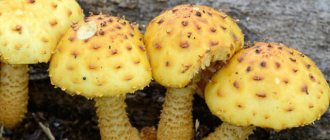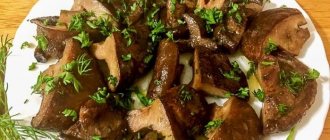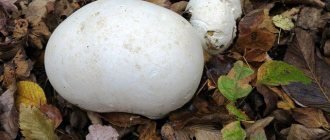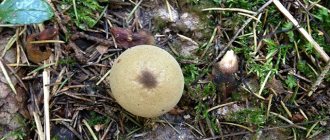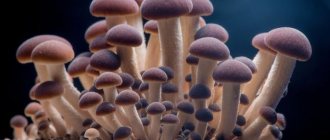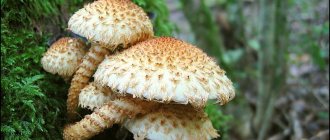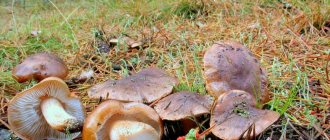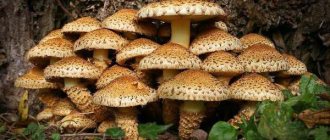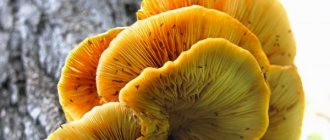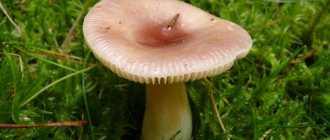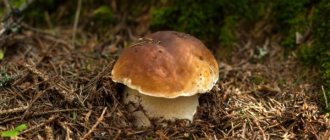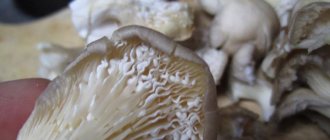Description
The flake is destructive.
Destroying scale is a fungus that parasitizes wood and decomposes it as it feeds.
hat
It can grow up to 20 cm and has a convex-spherical shape. Its color ranges from whitish to yellowish or light brown. The entire surface of young mushrooms is densely covered with white, fibrous, scaly outgrowths. By maturity, the scales are reduced. The edges of the cap are characterized by undulation.
Leg
Poplar scale.
Size – up to 15*3 cm. It can be either central or eccentric, swollen in the lower part. It has the same color as the cap and is also scaly. In the upper third it has a small white ring, which is reduced by the time of ripening.
Spore-bearing layer
The hymenophore plates are frequent and thin, descending or accreting in relation to the stalk. White when young, they turn brown when mature.
Pulp
The main part of the fruiting body is white and only at the very bottom of the stem is brownish. The smell of the pulp is characterized as unpleasant, and the taste of young mushrooms is bitter, then becomes sweetish.
Spore powder
Rust brown.
Doubles and their differences
The poplar flake mushroom has no poisonous counterparts. But she is often confused with a similar double.
Common scale is a conditionally edible species that grows in coniferous and deciduous forests. Fruiting lasts from July to early autumn. The mushroom has a pale yellow hemispherical cap with numerous pointed scales. The pulp is fleshy, there is no smell. In adult specimens the taste is pungent, while in young specimens it is sweetish. After a long boil, small mushrooms can be used to prepare fried, stewed and pickled dishes.
Similar species
Similar to destructive flakes:
- The scales are golden.
It has a more flattened cap shape and a yellowish color. The leg is thinner, the scales on it are brownish, not white. The mushroom is edible and distributed almost everywhere in Russia.
- Cinder scale.
It is distinguished by its small (up to 6 cm across the cap) size, slimy surface and reddish scales. Inedible. Grows on burnt wood.
1-Golden flake. 2-Cinder flake.
All of these species grow on a woody substrate, predominantly of deciduous species.
Taste qualities of flakes
Despite the fact that mushroom pickers believe that flakes are inedible and even poisonous, this is not entirely correct. These mushrooms do not contain toxic substances, so they cannot cause harm to health. Many of them do have some bitterness, but you can get rid of it using the usual methods - soaking in cold water and boiling.
In addition, some types (for example, edible flake) do not taste bitter at all, so dishes based on it can be prepared without any special pre-treatment. Although the flake does not have a strong mushroom aroma, nevertheless, different types of this mushroom are quite common in the forest zone, and they can be eaten if you learn to distinguish between different types well and know the technologies for preparing for frying, boiling or pickling.
Use in folk medicine
Medicinal products (decoctions, infusions, tinctures) are prepared from foliots, which are used by traditional healers in the treatment of diseases of the cardiovascular system (atherosclerosis, arterial hypertension, varicose veins, thrombophlebitis). Iron and magnesium foliot help increase hemoglobin levels, so introducing these mushrooms into the diet will be useful for anemia and thyroid diseases.
Thanks to the large amount of fiber in the pulp, royal honey mushrooms prevent constipation. The presence of squarrosidine in the pulp of royal mushrooms makes them an indispensable food for people suffering from gout. Moth preparations are used in folk medicine as an emetic and laxative.
Due to its low calorie content, royal mushrooms are included in the diet of diabetics, vegetarians and people on a diet. It has been scientifically proven that fresh golden foliot extract inhibits the growth of Ehrlich carcinoma and sarcoma-180 in laboratory mice.
Possible harm
In addition to its beneficial properties, royal honey mushrooms can also have harmful effects on the human body. Their harm may be due to various factors:
- They belong to the inedible types of flakes.
- Collected in places with unfavorable environmental conditions (near landfills, cattle burial grounds, along roads, in industrial zones).
- They are overripe or wormy.
Eating edible types of flakes is contraindicated in case of individual intolerance and allergies.
With gastritis, pancreatitis, cholecystitis and kidney disorders, taking foliot in food can cause an exacerbation.
Children's age, pregnancy and breastfeeding are also absolute contraindications to eating foliot.
It is strictly forbidden to simultaneously consume royal honey mushrooms and alcoholic beverages. It has been scientifically established that when they are taken simultaneously, disulfiram-like (coprine) syndrome develops.
This syndrome manifests itself in the form of symptoms of acute intoxication with intermediate breakdown products of alcohol:
- rush of blood to the face;
- tinnitus;
- nausea and vomiting;
- abdominal pain;
- increased body temperature;
- rapid heartbeat;
- difficulty breathing;
- panic state.
In severe cases, collapsed states, coma or respiratory arrest may develop.
The pulp of these mushrooms also contains meconic acid, which is a derivative of opium. Therefore, in some cases, when royal honey mushrooms are consumed without prior boiling, psychedelic states may develop, accompanied by auditory and visual hallucinations.
An excerpt characterizing the fiery scale
“She’s not entirely healthy,” said Mlle Bourienne, smiling cheerfully, “she won’t come out.” This is so understandable in her situation. - Hm! hmm! ugh! ugh! - said the prince and sat down at the table. The plate did not seem clean to him; he pointed to the spot and threw it. Tikhon picked it up and handed it to the barman. The little princess was not unwell; but she was so insurmountably afraid of the prince that, having heard how out of sorts he was, she decided not to go out. “I’m afraid for the child,” she said to m lle Bourienne, “God knows what can happen from fright.” In general, the little princess lived in Bald Mountains constantly under a feeling of fear and antipathy towards the old prince, which she was not aware of, because fear was so dominant that she could not feel it. There was also antipathy on the part of the prince, but it was drowned out by contempt. The princess, having settled down in the Bald Mountains, especially fell in love with m lle Bourienne, spent her days with her, asked her to spend the night with her, and often talked to her about her father-in-law and judged him. “Il nous arrive du monde, mon prince,” said M lle Bourienne, unfolding a white napkin with her pink hands. – Son excellence le prince Kouraguine avec son fils, a ce que j'ai entendu dire? – she said questioningly. “Hm... this boy of excellence... I assigned him to the college,” the prince said offended. “Why son, I can’t understand.” Princess Lizaveta Karlovna and Princess Marya may know; I don’t know why he’s bringing this son here. I don't need it. – And he looked at his blushing daughter. - Unwell, or what? Out of fear of the minister, as that idiot Alpatych said today. - No, mon pere. No matter how unsuccessfully M lle Bourienne found herself on the subject of conversation, she did not stop and chatted about greenhouses, about the beauty of a new blossoming flower, and the prince softened after the soup.
Growing flakes at home
Of all the types of scales, the nameko honey fungus, also known as edible scale, or mucous scale, is the most cultivable. This mushroom is very popular in Asian cooking, especially loved by the Japanese and Chinese, who grow nameko on an industrial scale.
By the way, edible flakes can also be found in our retail chain. Jars of canned mushrooms on the shelves of our supermarkets are very often filled with Nameko honey mushrooms. However, due to the fact that this mushroom is very new to the domestic buyer, marketers prefer not to indicate the name of the canned mushroom, so as not to confuse the timid domestic consumer.
Substrates made from waste from the wood processing industry, as well as some types of agricultural production, are excellent for growing mucous flakes. In other words, the nutrient medium for the development of mycelium and the appearance of fruiting bodies is sawdust (primarily deciduous trees) or chopped straw, to which sunflower husks, wheat bran, chopped corn cobs, etc. are added.
The resulting substrate is sterilized by keeping it at a temperature of about 100°C for 5 hours. For convenience and reliability, it is recommended to form small blocks from the substrate in advance, sterilizing them in this form, and not as a total mass. Then the substrate must be moistened, bringing the humidity to 65-70%.
Mycelium can be purchased either at a gardening store or online. The planting rate is 5% by weight of the substrate. In this case, the mycelium must be planted under sterile conditions and at a temperature not exceeding 30°C.
After this, the substrate is placed in a room (or incubation chamber) with a temperature of about 27°C for 2-3 weeks. At this stage, the flakes do not require lighting, but the air humidity must be maintained at about 80%.
After the specified period, the substrate overgrown with mycelium is transferred to another room, where the air temperature is about 11 ° C and the humidity is at least 98%. At the same time, the substrate needs normal air exchange, so it is no longer possible to keep it in tight bags.
As soon as the first rudiments of fruiting bodies appear on the substrate, their growth should be stimulated by increasing the air temperature by an average of 5°C. You can also reduce the humidity a little - literally by 5-10%. At this stage, you need to provide good lighting for at least 10-12 hours a day.
Having maintained the technology, you can collect mushrooms with a total weight of up to 30% of the weight of the original substrate.
There is an alternative method that imitates the natural conditions in which the scaly mushroom grows. We are talking about solid wood. A stump or a block of deciduous wood is suitable for these purposes. It is best to use aspen, poplar, willow, or birch. Some fruit trees also perform well, for example, walnut, apple, and plum.
The mycelium must be placed in pre-made cuts in the wood. It is recommended to make simple holes using a drill, placing them at a distance of at least 15 cm from each other. The depth of the cuts should be about 4 cm and the diameter no more than 3 cm.
Some amateur mushroom pickers also practice a very unusual method - they split the log lengthwise, pour a thin layer of mycelium into the split, and then, putting the halves together, twist them tightly with wire.
Scales (foliota, royal honey fungus, willow) are mushrooms of the strophariaceae family. These bright “prickly” mushrooms decorate the autumn forest. In our country, it is not customary to collect and eat foliots, but in Japan and China they are cultivated on an industrial scale.
These mushrooms are mostly inedible because their pulp has an unpleasant taste and odor. However, those types of mushrooms whose pulp is edible are valued by experienced mushroom pickers and are used by them along with real honey mushrooms.
conclusions
Scales are not very popular mushrooms among Russian mushroom pickers. Of the 30 species of foliot that grow in the deciduous forests of Russia, only three are edible and can be eaten along with other edible mushrooms. These are ordinary, golden and gum-bearing flakes.
These mushrooms contain all the nutrients, vitamins and minerals necessary for the human body. Due to their chemical composition, they have beneficial properties for the circulatory system, digestive organs, metabolism and hematopoiesis. Can be taken as a treatment for gout.
In terms of their nutritional value, foliots are mushrooms of the fourth category. Before cooking, they must be boiled, and only then added to first and second courses, salads, sauces, baked goods, fried, pickled, and salted.
If used incorrectly, edible foliots can also exhibit harmful properties. The most dangerous condition can develop in people who drink alcohol at the same time as these mushrooms - this is coprine syndrome, severe intoxication. In severe cases, collapse, coma and even death can occur.
- Serzhanin G.I. – Cap mushrooms of Belarus: Key and summary of the flora. – Minsk: Science and Technology, 1984.
- Life of plants: in 6 volumes. — M.: Enlightenment. Edited by A. L. Takhtadzhyan, editor-in-chief, corresponding member. USSR Academy of Sciences, prof. A. A. Fedorov. – 1974
More fresh and relevant information about health on our Telegram channel. Subscribe: https://t.me/foodandhealthru
Specialty: infectious disease specialist, gastroenterologist, pulmonologist.
Total experience: 35 years.
Education: 1975-1982, 1st MMI, San-Gig, highest qualification, infectious disease doctor.
Scientific degree: doctor of the highest category, candidate of medical sciences.
Training:
- Infectious diseases.
- Parasitic diseases.
- Emergency conditions.
- HIV.
Use in cooking
Only ordinary, golden, gum-bearing foliots and nameko honey mushrooms are used in cooking, because they have pulp with a pleasant smell and a typical mushroom taste, similar to the taste of real honey mushrooms.
These mushrooms can be prepared in different ways:
- add to soups, main courses, baking fillings, sauces and salads;
- fry;
- marinate;
- salt.
It is not customary to dry the flakes.
You should not prepare fresh foliots: they can cause dyspeptic symptoms. Before cooking, royal honey mushrooms must be boiled to avoid these digestive problems. The mushroom broth must be drained.
You can eat the entire fruiting body of the mushroom, but experienced chefs recommend using the caps for hot dishes, and the whole body for pickles and pickling.
Useful properties of flakes
Along with the fact that flake, like most other mushrooms, is low in calories (22 kcal per 100 g of live weight), its pulp has a rather rich chemical composition:
- there is a lot of calcium and phosphorus in golden flakes - almost as much as in river fish;
- these mushrooms contain a lot of hemoglobin;
- they also contain a whole group of vitamins - B1, B2, C, E, PP;
- dietary fiber that improves intestinal function;
- monosaccharides and fatty acids;
- minerals and trace elements contained in large quantities help improve metabolic processes, in particular, optimize the functioning of the thyroid gland.
Features of preparing flakes
Almost all flakes should be soaked in cold water for 1-2 days, changing twice a day. And royal honey mushrooms (golden flakes) should be boiled for 15-20 minutes at low boil.
Basically, these mushrooms are used in recipes, which are in no way inferior in taste to classic honey mushrooms. Here is an example of a recipe developed by French chefs - mushroom soup with melted cheese. For 12 royal mushrooms (can be frozen) you will need:
- 4 potatoes;
- 1 onion;
- 1 carrot;
- 3 processed cheese;
- herbs, spices to taste;
- water 1.5 l.
How to cook flake mushrooms (video)
The recipe is simple, but the taste of the soup is very rich - the combination of delicate cheese and pronounced mushroom aroma gives a very good combination:
- Potatoes are cut into small cubes, and carrots are grated on a coarse grater. The onion is chopped quite finely.
- The potatoes go into a saucepan and cook over medium heat. Finely chopped mushrooms are immediately placed there.
- Carrots and onions are fried until fully cooked.
- When the potatoes are completely ready, add onions and carrots, being careful not to pour out excess oil. At the same stage, add salt to taste.
- Now you need to bring everything to a boil again and pour all the contents through a sieve, rubbing all large fragments into a puree.
- Finely grated processed cheese is added to the finished soup.
- Add finely chopped greens. It would also be appropriate to add croutons, which are best made from dried baguette (can be fried with garlic) - then the dish will turn out in the best French traditions.
Thus, experienced and novice mushroom pickers should include flakes in their menu. These are not only tasty, but also healthy mushrooms that will suit the summer and winter tables. Bon appetit!
Recipes with flakes
Flakes are classified as conditionally edible mushrooms and that is why they must first be soaked in water for a long time, or boiled in water with added salt. Suitable for marinating and frying.
Fried mushrooms in sour cream
Peel the flakes and pour boiling water over them. Boil for twenty minutes at medium heat. Then place in a frying pan heated with butter and simmer along with sour cream and herbs for twenty minutes.
The fruits are fleshy and porous, but do not have a strong taste.
Pickled flakes
In this form, mushrooms can be consumed no later than three months later. They need to be stored in sterilized jars. To prepare you will need:
- wine vinegar - 3 tablespoons;
- flakes - 400 g;
- sunflower oil - 3 tablespoons;
- spices (allspice, cloves, bay) - to taste;
- granulated sugar - 1 teaspoon;
- garlic - 3 cloves;
- salt - to taste.
